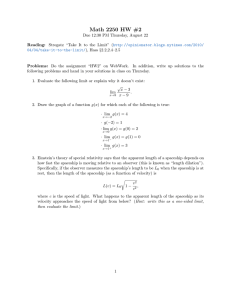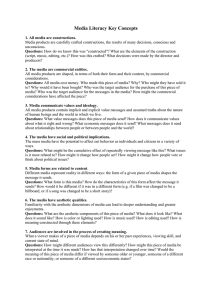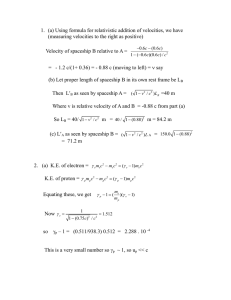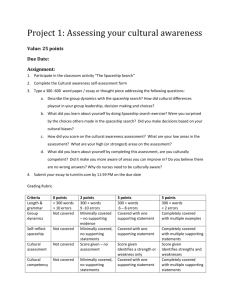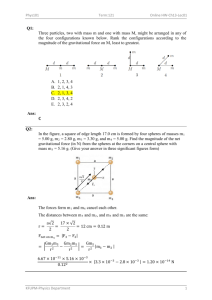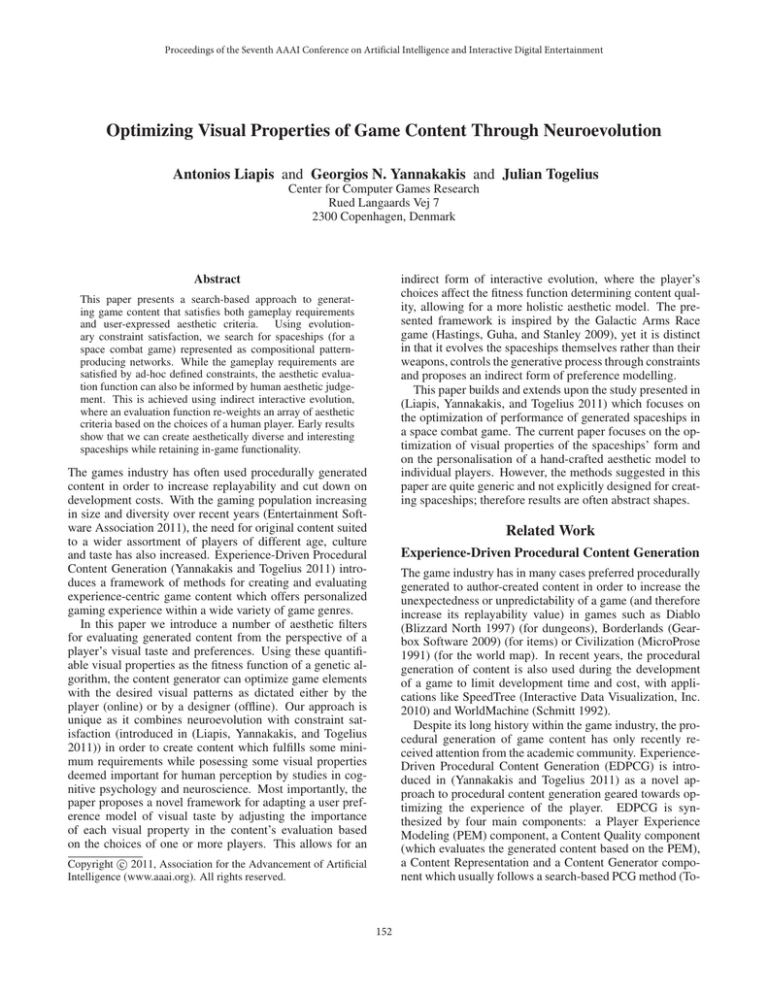
Proceedings of the Seventh AAAI Conference on Artificial Intelligence and Interactive Digital Entertainment
Optimizing Visual Properties of Game Content Through Neuroevolution
Antonios Liapis and Georgios N. Yannakakis and Julian Togelius
Center for Computer Games Research
Rued Langaards Vej 7
2300 Copenhagen, Denmark
indirect form of interactive evolution, where the player’s
choices affect the fitness function determining content quality, allowing for a more holistic aesthetic model. The presented framework is inspired by the Galactic Arms Race
game (Hastings, Guha, and Stanley 2009), yet it is distinct
in that it evolves the spaceships themselves rather than their
weapons, controls the generative process through constraints
and proposes an indirect form of preference modelling.
This paper builds and extends upon the study presented in
(Liapis, Yannakakis, and Togelius 2011) which focuses on
the optimization of performance of generated spaceships in
a space combat game. The current paper focuses on the optimization of visual properties of the spaceships’ form and
on the personalisation of a hand-crafted aesthetic model to
individual players. However, the methods suggested in this
paper are quite generic and not explicitly designed for creating spaceships; therefore results are often abstract shapes.
Abstract
This paper presents a search-based approach to generating game content that satisfies both gameplay requirements
and user-expressed aesthetic criteria. Using evolutionary constraint satisfaction, we search for spaceships (for a
space combat game) represented as compositional patternproducing networks. While the gameplay requirements are
satisfied by ad-hoc defined constraints, the aesthetic evaluation function can also be informed by human aesthetic judgement. This is achieved using indirect interactive evolution,
where an evaluation function re-weights an array of aesthetic
criteria based on the choices of a human player. Early results
show that we can create aesthetically diverse and interesting
spaceships while retaining in-game functionality.
The games industry has often used procedurally generated
content in order to increase replayability and cut down on
development costs. With the gaming population increasing
in size and diversity over recent years (Entertainment Software Association 2011), the need for original content suited
to a wider assortment of players of different age, culture
and taste has also increased. Experience-Driven Procedural
Content Generation (Yannakakis and Togelius 2011) introduces a framework of methods for creating and evaluating
experience-centric game content which offers personalized
gaming experience within a wide variety of game genres.
In this paper we introduce a number of aesthetic filters
for evaluating generated content from the perspective of a
player’s visual taste and preferences. Using these quantifiable visual properties as the fitness function of a genetic algorithm, the content generator can optimize game elements
with the desired visual patterns as dictated either by the
player (online) or by a designer (offline). Our approach is
unique as it combines neuroevolution with constraint satisfaction (introduced in (Liapis, Yannakakis, and Togelius
2011)) in order to create content which fulfills some minimum requirements while posessing some visual properties
deemed important for human perception by studies in cognitive psychology and neuroscience. Most importantly, the
paper proposes a novel framework for adapting a user preference model of visual taste by adjusting the importance
of each visual property in the content’s evaluation based
on the choices of one or more players. This allows for an
Related Work
Experience-Driven Procedural Content Generation
The game industry has in many cases preferred procedurally
generated to author-created content in order to increase the
unexpectedness or unpredictability of a game (and therefore
increase its replayability value) in games such as Diablo
(Blizzard North 1997) (for dungeons), Borderlands (Gearbox Software 2009) (for items) or Civilization (MicroProse
1991) (for the world map). In recent years, the procedural
generation of content is also used during the development
of a game to limit development time and cost, with applications like SpeedTree (Interactive Data Visualization, Inc.
2010) and WorldMachine (Schmitt 1992).
Despite its long history within the game industry, the procedural generation of game content has only recently received attention from the academic community. ExperienceDriven Procedural Content Generation (EDPCG) is introduced in (Yannakakis and Togelius 2011) as a novel approach to procedural content generation geared towards optimizing the experience of the player. EDPCG is synthesized by four main components: a Player Experience
Modeling (PEM) component, a Content Quality component
(which evaluates the generated content based on the PEM),
a Content Representation and a Content Generator component which usually follows a search-based PCG method (To-
c 2011, Association for the Advancement of Artificial
Copyright Intelligence (www.aaai.org). All rights reserved.
152
gelius et al. 2010). The EDPCG approach described in this
paper provides an efficient method for constrained optimization, a versatile model for content representation, an evaluation of visual quality rooted in theories of human perception
and an inclusive aesthetic model which can be adjusted to
the player’s preferences.
Interactive Evolution
Many EDPCG projects use an ad-hoc designed fitness function to assess content quality while others use interaction
with a human to guide evolution. Interactive Evolutionary
Computation (IEC) is “the technology in which EC optimizes the target systems based on subjective human evaluation as fitness values for system outputs” (Takagi 2001) and
is used extensively for content whose quality is subjective
and difficult to quantify. At its core, IEC utilizes a human
user to select individuals which will breed to create a new
generation. IEC is limited by the fact that user interest drops
as the number of choices they have to make increases. In
order to avoid user fatigue, most IEC projects find shortcuts
for reducing the number of choices imposed on their users.
In the current literature, IEC is used within EDPCG either
to provide an indirect player model based solely on gameplay metrics (side-stepping user fatigue) (Hastings, Guha,
and Stanley 2009) or to model a direct mapping between the
content and a desired player experience which is provided
either explicitly (e.g. through self-reports) or implicitly (e.g.
through biofeedback) (Pedersen, Togelius, and Yannakakis
2010). The interactive aesthetic model presented in this paper is closer to the latter approach, as it provides a direct
mapping between content and visual taste.
Figure 1: A generated spaceship, in graphical display (left)
and within the game environment (right). W represents a
weapon and T represents a thruster.
perception. This section presents the process of the spaceship’s generation and its evaluation, and the tools for its optimization. For space considerations the spaceship representation and the constrained optimization algorithm used are
presented briefly; more details on the methodology followed
can be found in (Liapis, Yannakakis, and Togelius 2011).
Representation
The generated spaceships are encoded as Compositional
Pattern-Producing Networks (CPPNs) (Stanley 2006) which
are specifically designed to represent content with regularities and which are capable of being optimized through artificial evolution. The CPPN receives a sequence of inputs in
the form of 2D coordinates (64 equidistant points on a circle) and returns a sequence of outputs corresponding to the
points of the spaceship hull’s pattern. Each output vector
consist of the 2D coordinates X and Y of each point and a
value which indicates if the point has a weapon or thruster
attached, if any. This sequence of outputs is translated into
the spaceship’s hull coordinates as well as specific weapon
and thruster types according to a collection of game-specific
parameters.
Universal principles of visual perception
Many EDPCG (and evolutionary art) projects argue that interactive evolution is a necessity, since purely stylistic or
aesthetic preferences are very difficult to recognize. However, research in cognitive psychology and neurobiology has
established certain universal properties of form which are ingrained in human perception and are not subject to cultural
trends. Ramachandran has suggested “speculative and arbitrary” laws of art, such as symmetry, grounded mostly on experiments and empirical studies of the brain (Ramachandran
and Hirstein 1999). On the other hand, Arnheim used cognitive psychology to analyze the aesthetic appeal of shapes
and paintings within the art domain (Arnheim 1954). Introducing the term perceptual forces as the psychological and
physical forces that guide the viewers’ attention at specific
points and along specific axes of an object or scene, Arnheim attempted to identify the most important contributors
to the creation of these forces, such as weight and direction.
Constrained optimization
The CPPNs which encode the generated spaceships are optimized through Neuroevolution of Augmenting Topologies
(Stanley and Miikkulainen 2002) in which an initial population of simple networks is iteratively augmented through
mutations, with similar networks being grouped together
into species and sharing their characteristics (links, nodes,
weights) through recombination. The presented neuroevolution approach satisfies the constraints imposed by the game
environment, the physics engine or the designer by simultaneously evolving two different populations. One population
includes all feasible individuals and is optimized according
to the objective function detailed in the following section
while the other includes all infeasible individuals, and its fitness function is based on the total distance from feasibility
for all violated constraints. This two-population neuroevolution builds upon the work of (Kimbrough et al. 2008), which
proposes that by minimizing the distance from feasibility for
the infeasible population, their members will exist on the
Methodology
The type of game content evaluated and optimized is a twodimensional spaceship (see Fig. 1). The spaceship consists
of a single polygon representing the hull, while weapons and
thrusters are attached to the edges of this hull. The spaceship must fulfil some minimum requirements; if it does, its
aesthetic quality is evaluated based on principles of visual
153
(a) Bottom Half
Figure 3: Direction as
the least squares line.
(b) Mid Third (on X axis)
Figure 4: Containment within
a triangle pointing forward.
Figure 2: Example weight distributions.
Containment builds on the notion of weight, but the “focus” part of the spaceship’s hull is determined by a more
complex shape acting as a “cookie cutter” (see Fig. 4). The
fitness score for containment is computed as:
boundary of feasible space, where the optimum solution often lies (Schoenauer and Michalewicz 1996).
Aesthetic evaluation
fC = Ac /A
Inspired from the works of Ramachandran and Arnheim,
some of the most important visual properties of the 2D
spaceships are symmetry, weight and direction. This paper presents a set of four significant visual properties of
the spaceship’s hull, while more aesthetic properties, including weapon- and thruster-specific ones can be found in (Liapis 2011). Visual quality is assessed solely on the spaceship hull’s shape (ignoring color, lighting and other aesthetic properties) because, with the current representation,
the spaceship’s form has the greatest representational freedom (and therefore intrinsic value). Additionally, the spaceship hull’s shape also determines the spaceship’s mass, centroid and alignment of thrusters and weapons, therefore affecting the spaceship’s movement pattern and, indirectly, its
overall performance.
Symmetry can be measured by reflecting the hull of the
spaceship along an axis passing from its midpoint. The fitness score for symmetry is computed as:
(1)
fS = A∩ /A∪
where A∩ the surface of the common area in the base and the
reflected shape and A∪ the surface of the area occupied by
either the base or the reflected shape.
Weight (or weight distribution) can be measured by calculating the surface of a “focus” part of the spaceship’s hull
(see Fig. 2). The fitness score for weight is computed as:
(2)
fW = μW (A p /A)
where A p the surface of the “focus” part of the spaceship’s
hull and A the surface of the entire spaceship’s hull. μW (x)
is a membership function indicative of the proximity with
the desired weight distribution in the “focus” part.
Direction is measured by the angle of the least squares
line of the hull’s points (see Fig. 3). The fitness score for
direction is computed as:
(3)
fD = μD (φ )
where φ the angle between the least squares line and the
positive Y axis, and μD a membership function indicative of
the proximity with a desired angle.
(4)
where Ac the surface of the part of the spaceship’s hull contained within the designated shape and A the surface of the
entire spaceship’s hull.
Interactive adaptation of the aesthetic model
The individual fitness scores presented in the previous section can be used on their own to optimize a single visual
property such as symmetry or direction, or can be aggregated into a weighted sum representing a more inclusive
aesthetic model. By using a weighted sum as the feasible fitness, the constrained optimizer can create content with high
scores in many different visual properties. In such cases,
the fitness function (also identified as aesthetic score or F),
is the weighted sum normalized to [0, 1]. Using a weighted
sum for deriving a single fitness score allows for the weights
of this quality approximation to be adjusted in a straightforward fashion based on in-game player’s choices. Through
this weighted sum, the evolution’s objective function subsititutes user input with a personalised aesthetic model and
limits user fatigue.
Treating the aesthetic score F as a single artificial neuron with a linear activation function allows this quality approximation to incrementally adjust its weights towards the
desired output as dictated by player choices. If a player is
presented with a single spaceship, selecting it corresponds
to a desired output of 1 and discarding it corresponds to a
desired output of 0. If presented with more than one spaceships, the user selects one and discards the others; in order to
take both selected and discarded spaceships’ visual properties into account, weight adjustment is performed according
to eq. (5), which is a variation of the weight update rule,
until the selected spaceship has a higher aesthetic score than
all unselected ones:
∂ Fu j
∂ Fs Nu
(5)
+ ∑ Fu j
Δwi = −η (Fs − 1)
∂ wi j=1
∂ wi
where wi the weight for the i-th visual property, η the learning rate, Fs the aesthetic score of the selected spaceship, Fu j
154
Table 1: Fitness of the best individual at the beginning and
the end of constrained optimization of a single visual property across 5 individual runs.
f1
f2
f3
f4
f5
First
Mean
0.77 0.00 0.00 0.72 0.53
feasible
St.Dev 0.19 0.01 0.00 0.30 0.12
After
Mean
1.00 1.00 1.00 1.00 0.96
100 gen. St.Dev 0.00 0.00 0.00 0.00 0.01
Table 2: Fitness (F) of the best individual at the end of constrained optimization of five visual properties, and its components ( f1 to f5 ) among 10 individual runs.
F
f1
f2
f3
f4
f5
Mean
0.73 0.78 0.89 0.19 0.98 0.80
St.Dev 0.04 0.15 0.31 0.40 0.04 0.10
Each of the five visual properties show different behaviors
in their optimization. Because the sequence of points used
as input to the CPPN are on a circle which is symmetrical
along the X and Y axis, the resulting spaceships (especially
with simple networks) are more likely to be symmetrical ( f1 )
and very unlikely to have the desired weight distribution of
f2 and f3 . Since the membership function of f2 and f3 is
very specific (returning 0 or near 0 for most shapes and high
fitness scores only for shapes with the desired pattern), only
the complexification of networks guided by the continuous
fitness score fW can lead to the discovery of individuals with
the desired weight distribution. Unlike weight distribution,
containment ( f5 ) has no membership function and therefore
many shapes may have average or high fitness scores for
it. The same applies to direction ( f4 ), whose membership
function has high scores for many different angles φ .
the aesthetic score of the j-th unselected spaceship and Nu
the number of presented spaceships that were not selected.
Experiments
This section presents the results of the neuroevolutionary
constrained optimization algorithm when one or more visual
properties are targeted, and concludes with an experiment in
adaptive content generation using a player-dependent aesthetic model.
Offline optimization of a single visual property
Each of the visual properties identified in the previous section can be used on their own as a fitness function for feasible individuals in the constrained optimization algorithm.
This section demonstrates the optimization process of five
different visual properties; these visual properties and their
corresponding fitness scores ( f1 to f5 ) are as follows:
f1 is the fitness score for symmetry (see eq. (1)) with the
axis of symmetry being a line parallel to the world’s Y
axis and passing through the spaceship’s midpoint.
(a) f1 =1.00 (b) f2 =1.00 (c) f3 =1.00 (d) f4 =1.00 (e) f5 =0.98
f2 is the fitness score for weight (see eq. (2)) using the
bottom half of the spaceship as the “focus” part (see
Figure 5: Best final individuals among 5 independent runs
for the different visual properties being optimized.
Fig.2(a)) and μW.75 (x) = e
function μW (x).
−(x−0.75)2
2·0.0332
as the membership
Offline optimization of multiple visual properties
f3 is the fitness score for weight (see eq. (2)) using the mid
third of the spaceship (on the X axis) as the “focus” part
(see Fig. 2(b)) and μW.75 (x) as the membership function
μW (x) (described above).
While the optimization of a single visual property leads to
highly fit content, it is only through the combination of different visual patterns that a meaningful spaceship shape can
be identified. This section presents an experiment which
uses the normalized weighted sum (all weights at 1) of the
fitness scores f1 to f5 as its objective function F. The results of the optimization process for 100 generations on a
population of 250 individuals are shown in Table 2 collected
through 10 individual runs, while the progress of the best individual for the most successful run is also presented graphically in Fig. 6.
Fig. 6 shows an overall increase of the aesthetic score F
from its initial values; however, Table 2 indicates that not
all of the contributing visual properties are optimized to the
same degree. The most noteable disparity are the two weight
properties ( f2 and f3 ). In the final best individuals, f2 is the
highest scoring among the contributing visual properties in
all but one runs, while in only two runs does the best spaceship have a contribution from f3 ; however, both f2 and f3
have a very similar behavior when optimized on their own.
A number of factors affect this outcome: firstly, f2 and f3
have a membership function μW which requires a very spe-
f4 is the fitness score for direction (see eq. (3)) evaluating
proximity with the Y axis and with μD (x) = |sin(x)|.
f5 is the fitness score for containment (see eq. (4)) using
a forward-pointing triangle as the containing form (see
Fig. 4).
Table 1 presents the fitness scores of the best feasible individuals at the beginning and the end of a constrained optimization process (after 100 generations), with a population
of 250 individuals. The means and standard deviations are
calculated from 5 individual runs. The first feasible individual in the population is used in the calculation of initial scores regardless of the generation it occured. Fig. 5
presents the best final individuals among the 5 different runs;
since the presence of thrusters and weapons is neither necessary (for functional purposes) nor contributes to the evaluation of visual properties, the generated spaceships have no
thrusters or weapons attached.
155
Online adaptation of the aesthetic model and the
generated content
As a proof of concept for the interactive adaptation of the
aesthetic model presented in the previous section, an experiment was conducted using the online adjustment of both the
aesthetic model and the content generated based on it.
The experiment revolves around a series of iterations: in
each iteration a range of shapes is presented and the user
selects the preferred one among them. Based on this selection the aesthetic score is re-evaluated according to eq. (5)
and new shapes are evolved from those currently presented
using an objective function from the updated aesthetics. In
order to make online evolution manageable in terms of time,
the initial shapes were loaded from a pretrained collection,
the total population (feasible and infeasible) was limited to
40 individuals and the number of generations between each
iteration was limited to 5. Furthermore, instead of the inclusive aesthetic model only two visual properties were evaluated and optimized during each iteration. Choosing from a
large pool of visual properties, the two properties with “the
most different” scores between the selected individual and
all unselected ones are chosen and combined together into a
weighted sum serving as the objective function for the current iteration. The difference (δi ) with regards to a visual
property i is computed as:
Figure 6: Stacked area plot of the best individual’s optimization progress using a model of five visual properties. Also
displayed are the phenotypes of the first feasible individual
(far left) and the best individuals in 20 generation intervals.
δi =
N
∑ | fik − fis |
(6)
k=1
k=s
where s is the selected individual, N is the number of presented individuals and fik is the score of individual k for the
i-th visual property.
cific visual pattern, so most spaceships will either have a
score of 0 or a high score in these visual properties; a spaceship either has the desired weight distribution or it doesn’t.
Compared to aesthetic properties with a more lenient membership function (μD for f4 ) or none at all ( f1 , f5 ), a spaceship with the desired visual pattern for f2 or f3 has a large
advantage to one that does not; this is not true for the other
visual properties. Most shapes have a considerable score
for f1 , f4 or f5 since their desired visual patterns are much
more generic, while most shapes have a score of 0 for f2
and f3 . By design, therefore, any fW with the given membership function is expected to dominate the aggregated fitness score if the targeted weight distribution is found; this
explains why f2 is usually optimal in the best final spaceships. On the other hand f3 is mostly absent from the best
individuals because both f2 and f3 are pattern-specific: once
a spaceship with a high score in f2 is found, the discovery
of a spaceship with a high score in both f2 and f3 becomes
much less likely. Fig. 6 presents the only run where both
f2 and f3 have a high score at the end of the optimization
process.
Figure 7: Final results of the online evolutionary session for
five different participants.
The experiment included 26 participants, most of which
evolved content for 10 to 20 iterations. The same initial
spaceship shapes were presented to all participants, while
subsequent iterations presented only content which was distinct from each other. Although certain participants evolved
content which was not of particular visual interest (variations of skewed circles similar to the CPPN’s input), many
participants generated very different spaceship shapes at the
end of their sessions, both from each other and compared to
the initial shapes. For space considerations, Fig. 7 demonstrates the most interesting results of this experiment and
showcases the variety of spaceship designs which are driven
by personalized aesthetic models of participants. Despite the
fact that the framework focuses on genereating aesthetically
pleasing spaceships, users were not required to specifically
target spaceship shapes but were encouraged to choose any
shape they found most appealing. This explains why not
many of the final results bear any resemblance to spaceships;
As expected, the aggregated approach to optimizing multiple visual properties suffers from dominant solutions; however, it does manage to create spaceships with high fitness
scores for most contributing aesthetic properties and can be
even more successful with a more sophisticated selection of
targeted visual patterns.
156
the focus of this experiment was the potential of adapting a
context-independent personalized aesthetic model. In future
work, we will consider explicitly requiring that users choose
shapes appropriate for use as spaceship hulls.
in (Liapis, Yannakakis, and Togelius 2011), allows for a
personalized experience where the presented content is to
the player’s taste and its functionalities are tailored to their
playstyle or challenge level.
Conclusion
References
This paper presented a constraint satisfaction PCG framework used to optimize the shape of spaceships according to
visual properties deemed taste- and context-independent by
studies on the field of human perception. By ensuring that
constraints imposed by the game engine and a human designer are met by feasible individuals, the content generator
operates in a much more limited search space. The visual
properties presented in this paper are only a sample of possible quantifiable aesthetic characteristics that have been introduced in (Liapis 2011) pertaining to simplicity, cost, or
weapon- and thruster-specific properties. These aesthetic
evaluations can be used in conjunction with evaluations of
the generated content’s performance in game-specific tasks,
as presented in (Liapis, Yannakakis, and Togelius 2011), to
create both functional and visually appealing spaceships.
Experiments in the optimization of a single visual property have as a whole shown promising results. On the other
hand, the aggregation of multiple visual properties in a single fitness score (as a weighted sum) is not guaranteed to
generate results with all the required visual patterns. The
evaluation of content in the form of a weighted sum allows for the adaptation of this heuristic according to player
choices, allowing for the creation of personalized computational models of visual taste. For future work, we will
consider a multi-objective evolutionary approach for the optimization of multiple visual properties. The argument for
the aggregated approach is the potential for an interactive
aesthetic model; however, a lexicographic ordering method
could also take the aesthetic model into account by assigning
higher importance to visual properties with larger weights.
Although targeted visual properties are often achieved
within a number of generations using the proposed constrained optimizer, it should be noted that the resulting
shapes are not particularly reminiscent of spaceship hulls. In
future work we will limit the current representational freedom to ensure the generation of recognizeable spaceships.
The framework and algorithm proposed is applicable beyond the scope of spaceship design; the visual properties
presented in this paper can be applied to any 2D game element. Additionally, the evaluation of content quality can
be used as an authoring tool in game development: while
the neuroevolutionary constrained optimization of multiple
visual properties certainly has room for improvement, the
adaptive aesthetic model in the form of a weighted sum can
also be useful for evaluating existing content. This aesthetic
model can select the most suitable game content for a particular player’s visual taste from a collection of pre-generated
or procedurally generated content. The player’s choices can
be used to adapt the aesthetic model much like the experiment presented in this paper and without the need for online evolution of new content. The fact that such a personalized aesthetic model can be combined with the evaluation
of competencies in game-specific tasks, which is presented
Arnheim, R. 1954. Art and visual perception: a psychology of the
creative eye. University of California Press.
Blizzard North. 1997. Diablo.
Entertainment Software Association. 2011. Essential facts about
the computer and video game industry. Retrieved July 26, 2011,
from http://www.theesa.com/facts/pdfs/ESA˙EF˙2011.pdf.
Gearbox Software. 2009. Borderlands.
Hastings, E. J.; Guha, R. K.; and Stanley, K. O. 2009. Evolving
content in the galactic arms race video game. CIG’09: Proceedings
of the 5th international conference on Computational Intelligence
and Games 241–248.
Interactive Data Visualization, Inc. 2010. SpeedTree. Year refers
to the latest software release as of October 19, 2010.
Kimbrough, S. O.; Koehler, G. J.; Lu, M.; and Wood, D. H. 2008.
On a Feasible-Infeasible Two-Population (FI-2Pop) genetic algorithm for constrained optimization: Distance tracing and no free
lunch. European Journal of Operational Research 190(2):310–
327.
Liapis, A.; Yannakakis, G. N.; and Togelius, J. 2011. Neuroevolutionary Constrained Optimization for Content Creation. IEEE Conference on Computational Intelligence and Games (CIG), 2011.
Liapis, A. 2011. Optimizing Game Elements based on Aesthetic
and Performance principles and affected by Player preferences.
Master’s thesis, IT University of Copenhagen.
MicroProse. 1991. Sid Meier’s Civilization.
Pedersen, C.; Togelius, J.; and Yannakakis, G. N. 2010. Modeling
Player Experience for Content Creation. IEEE Transactions on
Computational Intelligence and AI in Games 2(1):54–67.
Ramachandran, V., and Hirstein, W. 1999. The science of art: a
neurological theory of aesthetic experience. Journal of consciousness Studies 6:15–51.
Schmitt, S. 1992. World Machine.
Schoenauer, M., and Michalewicz, Z. 1996. Evolutionary computation at the edge of feasibility. In PPSN IV: Proceedings of
the 4th International Conference on Parallel Problem Solving from
Nature, 245–254. London, UK: Springer-Verlag.
Stanley, K. O., and Miikkulainen, R. 2002. Evolving neural networks through augmenting topologies. Evolutionary Computation
10(2):99–127.
Stanley, K. O. 2006. Exploiting regularity without development.
In Proceedings of the AAAI Fall Symposium on Developmental Systems. Menlo Park, CA: AAAI Press.
Takagi, H. 2001. Interactive evolutionary computation: Fusion
of the capabilities of EC optimization and human evaluation. Proceedings of the IEEE 89(9):1275–1296. Invited Paper.
Togelius, J.; Yannakakis, G. N.; Stanley, K. O.; and Browne, C.
2010. Search-based procedural content generation. In Proceedings
of the EvoStar Conference. Springer-Verlag.
Yannakakis, G. N., and Togelius, J. 2011. Experience-Driven Procedural Content Generation. IEEE Transactions on Affective Computing.
157



